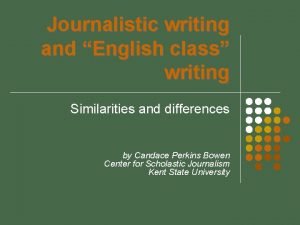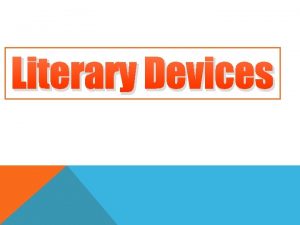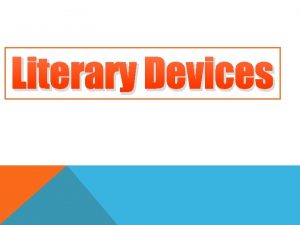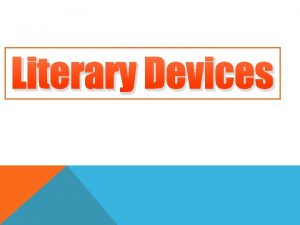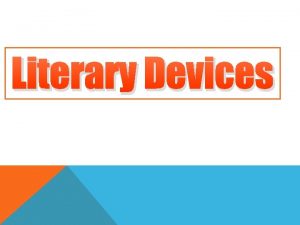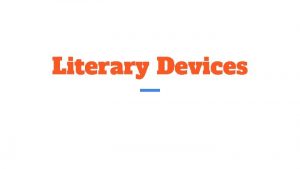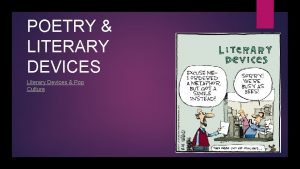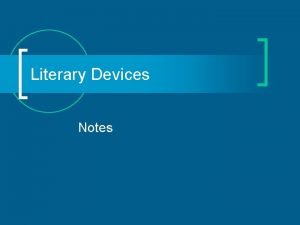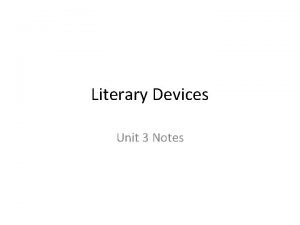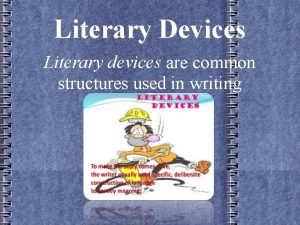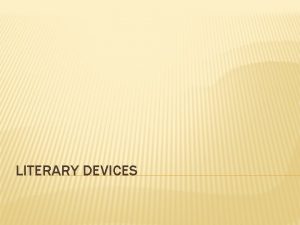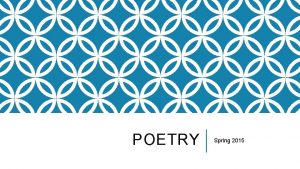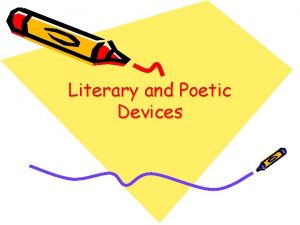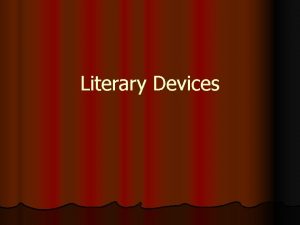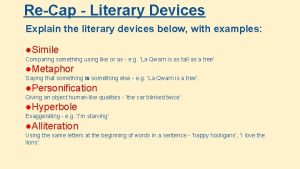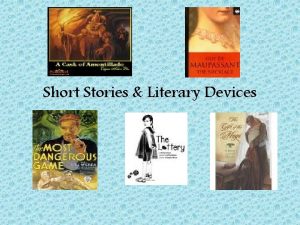Literary Devices The Art Of Writing What Are






















- Slides: 22

Literary Devices The Art Of Writing

What Are Literary Devices?

• Shakespeare's Romeo and Juliet has an edge-of-the-seat plot full of murder, love, feuding, and betrayal. Driving this tragic play forward is the fast-paced, witty, and convoluted dialogue of the script. Effectively capturing the audience's attention, Shakespeare has used a number of important literary devices, which serve to amuse, guide, and hypnotize the viewer of this production.

Puns A pun is a joke based on the use of a word, or more than one word, that has more than one meaning but the same sound. Mercutio and Romeo often exchange puns with one another in the play: Mercutio: "Nay, gentle Romeo, we must have you dance. " Romeo: "Not I, believe me. You have dancing shoes / With nimble soles; I have a soul of lead…" (I iv 13 -5) Romeo has used the word "sole" when referring to Mercutio's shoes, then made a pun by referring to his own "soul. "

examples • • I am reading a book on anti-gravity… How did you escape Iran? What was Forrest Gump’s password? Why was Cinderella thrown off the basketball team? She ran away from the ball. • I can’t believe I got fired from the calendar factory…all I did was take a day off!

Foreshadowing describes when a piece of dialogue or action in a work refers to events that will happen later in the story even though the characters have no prior knowledge such events will occur. In the following quote, Benvolio is consoling Romeo on his loss regarding Rosaline: Benvolio: "Take thou some new infection to thy eye, / And the rank poison of the old will die" (I ii 49 -50) Here Benvolio unknowingly foreshadows the fact that as soon as Romeo sees Juliet, the "new infection, " the "rank poison" of Rosaline dies and he can think only of his new Capulet love.

Metaphor A metaphor is a comparison in which an object or person is directly likened to something else that could be completely unrelated. The most famous metaphor in Romeo and Juliet is Romeo's monologue outside the Capulet orchard: Romeo: "But, soft! what light through yonder window breaks? / It is the east, and Juliet is the sun. " (II ii 2 -3) Here, Juliet is metaphorically compared to the sun despite the fact that she has nothing physically in common with a glowing star hundreds of thousands of miles away.

Similes are one of the most commonly used literary devices; referring to the practice of drawing parallels or comparisons between two unrelated and dissimilar things, people, beings, places and concepts. By using similes a greater degree of meaning and understanding is attached to an otherwise simple sentence. The reader is able to better understand the sentiment the author wishes to convey. Similes are marked by the use of the words ‘as’ or ‘such as’ or ‘like’. Example:

Personification occurs when an inanimate object or concept is given the qualities of a person or animal. This is exemplified when Juliet is waiting for her lover, Romeo, to come to her windowsill in the Capulet orchard. Juliet: "For thou wilt lie upon the wings of night / Whiter than new snow on a raven's back. / Come, gentle night, come, loving, black-brow'd night" (III ii 18 -20) Obviously, the night does not have wings, nor does it have a brow, but giving it these qualities adds a mystique to Juliet's monologue and a poetic quality to the language.

Oxymoron An oxymoron describes when two juxtaposed words have opposing or very diverse meanings. In the following quotation, Juliet has just learned that Romeo murdered her cousin, Tybalt, and she is venting her feelings of anger at her lover for hurting her family. Juliet: "Beautiful tyrant! fiend angelical!" (III ii 77) When Juliet refers to Romeo as a "beautiful tyrant, " she is expressing an oxymoron because the acts of a tyrant will rarely be referred to as beautiful.

examples • • • Jumbo Shrimp Act naturally Living dead Pretty ugly Only choice Alone together

Paradox A paradox is a statement or situation with seemingly contradictory or incompatible components. On closer examination, however, the combination of these components is indeed appropriate. For example, see how Juliet describes Romeo in the following quote: Juliet: "O serpent heart, hid with a flowering face!" (III ii 75) While Juliet knows that Romeo is not a serpent nor does he have a face full of flowers, her use of these descriptions show paradoxically he is her lover and the murderer of her cousin at the same time.

Hyperbole A hyperbole is a literary device wherein the author uses specific words and phrases that exaggerate and overemphasize the basic crux of the statement in order to produce a grander, more noticeable effect. The purpose of hyperbole is to create a larger-than-life effect and overly stress a specific point. Such sentences usually convey an action or sentiment that is generally not practically/ realistically possible or plausible but helps emphasize an emotion.

Examples • • • It’s so cold, I saw some polar bears wearing jackets My dad is always working. My dress shoes are killing me. Carrie never stops talking It is so hot, you could fry an egg on the sidewalk.

Irony The use of irony in literature refers to playing around with words such that the meaning implied by a sentence or word is actually different from the literal meaning. Often irony is used to suggest the stark contrast of the literal meaning being put forth. The deeper, real layer of significance is revealed not by the words themselves but the situation and the context in which they are placed. 3 types: Situational irony: The opposite of what you think https: //www. youtube. com/watch? v=tqg 6 RO 8 c_W 0 verbal irony: https: //www. youtube. com/watch? v=Ii. R-bn. CHIYo That's dramatic irony: https: //www. youtube. com/watch? v=RZFYu. X 84 n 1 U

Character Foil A foil is another character in a story who contrasts with the main character, usually to highlight one of their attributes. Example: Harry Potter Who would be a Character that may fit this? You may also think of other books, films, TV shows.

In the popular book series, Harry Potter, the character of Hogwarts principal Albus Dumbledore, who portrays ‘good’, is constantly shown to believe in the power of true love (of all forms and types) and is portrayed as a strong, benevolent and positive character while the antagonist Lord Voldemort, who depicts the evil and ‘bad’ in the series is constantly shown to mock and disbelieve the sentiment of love and think of it as a foolish indulgence, a trait that is finally his undoing

Soliloquies A soliloquy (from Latin solo "to oneself" + loquor "I talk") is a device often used in drama when a character speaks to himself or herself, relating thoughts and feelings, thereby also sharing them with the audience, giving off the illusion of being a series of unspoken reflections. Example from William Shakespear’s Hamlet: https: //www. youtube. com/watch? v=Sju. Zq-8 PUw 0

Comic Relief The use of a comic scene to interrupt a succession of intensely tragic dramatic moments. The comedy of scenes offering comic relief typically parallels the tragic action that the scenes interrupt. Comic relief is lacking in Greek tragedy, but occurs regularly in Shakespeare's tragedies. Shakespeare uses the comic roles of Mercutio and the Nurse to develop the roles of Romeo and Juliet as young tragic lovers. Prior to Tybalt and Mercutio's deaths, the Nurse had served primarily as comic relief.

Blank Verse unrhymed verse, especially the unrhymed iambic pentameter most frequently used in English dramatic, epic, and reflective verse.

Theme The theme of any literary work is the base that acts as a foundation for the entire literary piece. The theme links all aspects of the literary work with one another and is basically the main subject. The theme can be an enduring pattern or motif throughout the literary work, occurring in a complex, long winding manner or it can be short and succinct and provide a certain insight into the story. Example

• he main theme in the play Romeo and Juliet was love with smaller themes of sacrifice, tragedy, struggle, hardship, devotion and so on.
 Antigentest åre
Antigentest åre What are poetic devices in poems
What are poetic devices in poems Similarities of journalistic writing and literary writing
Similarities of journalistic writing and literary writing Hình ảnh bộ gõ cơ thể búng tay
Hình ảnh bộ gõ cơ thể búng tay Bổ thể
Bổ thể Tỉ lệ cơ thể trẻ em
Tỉ lệ cơ thể trẻ em Voi kéo gỗ như thế nào
Voi kéo gỗ như thế nào Chụp tư thế worms-breton
Chụp tư thế worms-breton Chúa yêu trần thế alleluia
Chúa yêu trần thế alleluia Môn thể thao bắt đầu bằng từ đua
Môn thể thao bắt đầu bằng từ đua Thế nào là hệ số cao nhất
Thế nào là hệ số cao nhất Các châu lục và đại dương trên thế giới
Các châu lục và đại dương trên thế giới Công thức tính thế năng
Công thức tính thế năng Trời xanh đây là của chúng ta thể thơ
Trời xanh đây là của chúng ta thể thơ Mật thư anh em như thể tay chân
Mật thư anh em như thể tay chân Làm thế nào để 102-1=99
Làm thế nào để 102-1=99 Phản ứng thế ankan
Phản ứng thế ankan Các châu lục và đại dương trên thế giới
Các châu lục và đại dương trên thế giới Thể thơ truyền thống
Thể thơ truyền thống Quá trình desamine hóa có thể tạo ra
Quá trình desamine hóa có thể tạo ra Một số thể thơ truyền thống
Một số thể thơ truyền thống Bàn tay mà dây bẩn
Bàn tay mà dây bẩn


